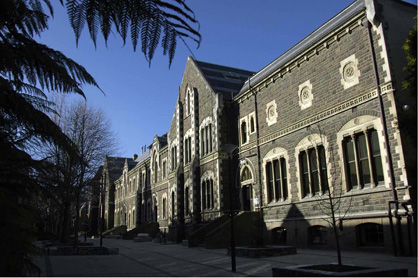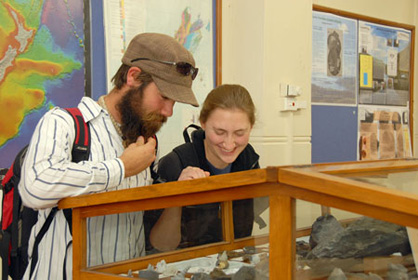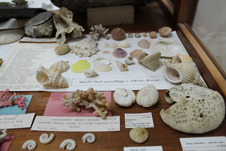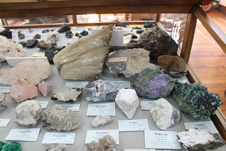Our Geology Museum, which is open to the public, contains large and significantly important collections of rocks, minerals and fossils – the largest such collection in the South Island. There are displays in the museum itself and in the adjacent foyer.
Location
The Geology Museum is located in the south end of the historic geology building.

Geology Building viewed from the south. The entrance to the Geology Museum is the closest stairs on the right.
Photo by R Ewan Fordyce.
Map of the Ground Floor of the Geology Building
Opening hours
The Museum is open to the public five days a week, from 9:00am to 5pm.
Material for researchers

The Geology Museum is used regularly by students. Here, two former international students are looking at the fossil displays.
If you visit the Geology Museum, you may look through large viewing windows to see fossils being worked on in the Fossil Preparation Laboratory (room Gs13a). The fossils include whales, dolphins, penguins, and fish.
Collections in the museum are used by staff, students and visitors for research and in undergraduate and postgraduate courses.
Material is regularly made available for scientific study by researchers. Please contact paleontology@otago.ac.nz for more information.
School group visits
We often host primary, intermediate and secondary school groups. If you wish to arrange a visit, please contact:
Email geology.outreach@otago.ac.nz
Contact
For general enquiries about the Geology Museum, please contact:
Email paleontology@otago.ac.nz
Collections
Collections in the museum are used by staff and students for research and in undergraduate and postgraduate courses.
Fossil Collections

Fossil collections in the geology museum
The Geology Department hosts three collections of fossils: vertebrates (animals with a backbone), invertebrates (animals without a backbone) and plants.
There are about 60,000 specimens listed in our hand-written fossil catalogue books; these are now being digitised into three searchable databases (see links below).
For all enquiries about our fossil collections, including general enquiries about fossils, questions regarding research collaboration or making arrangements for visiting researchers, please contact:
Email paleontology@otago.ac.nz
The fossil vertebrate collection
The Geology Department holds a significant collection of mostly marine vertebrates, varying from largely complete skeletons to single or partial bones and otoliths (fish earbones).
Of note are a few highly informative Late Cretaceous plesiosaurs and mosasaurs and numerous specimens of whales, dolphins, penguins, turtles, bony fish and sharks of Paleocene to Miocene age.
Access database: the Fossil Vertebrate Collection
The fossil invertebrate collection
The Geology Department holds large collections of marine invertebrates.
Of particular note are Ordovician graptolites; Permian, Triassic and Jurassic molluscs and brachiopods; brachiopods, molluscs, corals, barnacles, echinoderms, marine and freshwater crustacea, tiny foraminifera and ostracods of Eocene to Miocene age, and Miocene insects from Foulden Maar and other sites.
Access database: Fossil Invertebrate Collection
The fossil plant collection
The Geology Department holds many unique and important plant fossils, particularly from the Eocene to Miocene of Otago and Southland (localities include Pikopiko Fossil Forest, Foulden Maar, Hindon Maar, Newvale Mine, Lake Manuherikia and diatomaceous leaf beds around Dunedin). The material includes fossil leaves, wood, flowers, fruits, seeds, pollen and fungi.
Access database: Fossil Plant Collection
How to search the databases
Each of the three collections has its own database within the Specify Web Portal.
Search methods
The left hand side of the Specify Web Portal contains the Search Tools. There are two options for searching: Express and Advanced.
Below the 'Search Tools' heading are two check boxes. If you tick the Geo Coords box, only records from defined localities (latitude and longitude) will be shown. If you click on the Images box, only records with images will be shown.
Express search
The Express search allows you to enter a single word or number and the search engine will show all Records in the collection that include that word or number.
The word might be the 'common name' for an animal (e.g. whale) or a locality (e.g. Hakataramea) or a rock formation name (e.g. Kokoamu) or a rock type (e.g. limestone) or a geological stage (e.g. Duntroonian) or the type status (e.g. holotype) or the name of a prominent paleontologist (e.g. Fordyce or Lee), etc.
Advanced search
The Advanced search option allows you to be more specific. Clicking on the + symbol opens the column of data fields. On the far left is the name of the field, then a space where you can type a word or number and then a small downward arrow. This arrow gives you several options – it is best to use 'contains any'.
As an example, if you put 'Whale' into the Common name field and 'Holotype' into the Type Status field and Duntroonian into the Stage/Age field and hit the Search button (bottom left), the records of holotype specimens of Duntroonian age whales will be shown. Note that the Advanced search is very particular, using 'Holotype' and 'Whale' will work but using 'holotype' and 'whale' will not work.
Results
The main window of the Specify Web Portal displays the results of your search.
Each numbered line of information is one Record, which includes its catalogue number and information about a specimen or specimens. There is quite a lot of information included on the most important specimens.
If you double-click on a Record (a numbered line on the spreadsheet) a pop up box (Detail) will open to show all the information on that specimen in a more readable format. The Detail box contains two tabs: Images and Map. These display any Images of the specimen and a Map with the locality it was found.
At the top of the main window are three tabs: Records, Images, and Map.
Records
The Records tab shows a spreadsheet of text of information about the fossil specimens.
Images
The Images tab shows all images attached to those Records. Double click on the thumbnail to see a larger version image.
Map
The Map tab shows the locality where all the specimens in the Records were collected. If you click on a red marker on the map, a pop up box (Specimen) will open up with the information on that particular Record.
Rock and Mineral Collections

Mineral collections in the geology museum
Our Geology Department has arguably the largest and best rock and mineral collection in the South Island. Selected specimens are on display in the museum, and many more are stored for teaching and research purposes.
For more information on accessing our rock and mineral collections, please contact Dianne Nyhof.
